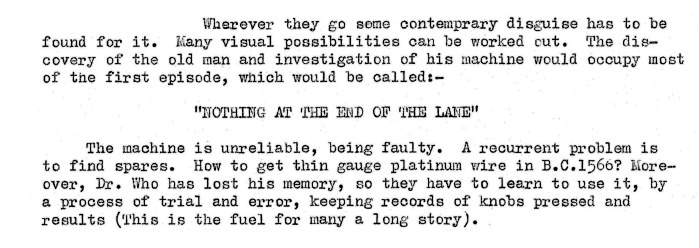



As a detail about the early development of Doctor Who that was discovered from archived production documents, it is an appropriate title for a magazine that focuses on the research and restoration of this long-running television series.



Richard Bignell - Editor
As a young child, Richard both loved and was terrified by Doctor Who in equal measure. Until he was ten, he watched the programme from behind the safety of a cushion, but he never missed an episode unless he had to. This led to a fascination with the programme, both in front of and behind the television camera.
For over 35 years, Richard has been involved with Doctor Who research and writing, producing material for the official Doctor Who Magazine, BBC Television and BBC Studios successful range of Doctor Who DVDs and Blu-rays. He has also written Doctor Who - On Location, the first published guidebook to the programme's filming locations.
Richard has been editing Nothing at the End of the Lane since 1999 and is proud of the reputation it has gained over the years as one of the foremost Doctor Who publications.
For over 35 years, Richard has been involved with Doctor Who research and writing, producing material for the official Doctor Who Magazine, BBC Television and BBC Studios successful range of Doctor Who DVDs and Blu-rays. He has also written Doctor Who - On Location, the first published guidebook to the programme's filming locations.
Richard has been editing Nothing at the End of the Lane since 1999 and is proud of the reputation it has gained over the years as one of the foremost Doctor Who publications.
So what is Nothing at the End of the Lane?
From its first transmission in November 1963, Doctor Who, probably more than any other programme, has charted the history and development of British television over the last 55 years. With a format that always put constant demands on the ingenuity and inventiveness of all the production teams involved, the programme has often been at the forefront in the use of new techniques and technologies. From its early days in the small, cramped studios at Lime Grove through to its current home at the BBC's Roath Lock Studios in Cardiff, the history of Doctor Who reflects how television as a medium has grown and developed over the past five decades.
Nothing at the End of the Lane is a magazine which focuses on the story behind and beyond the making of Doctor Who, looking not only at the programme's production but also at its distribution archiving, marketing and so on.
The magazine prides itself on being both detailed and accurate, wherever possible, going back to the primary sources of information - speaking directly with the many people involved in the many and varied aspects of the programme as well as locating and researching any original production materials that have survived over the years.
But where does the name Nothing at the End of the Lane come from?
When the BBC Written Archive Centre in Caversham first made the original production files for Doctor Who available for examination in 1993, researchers began to uncover a multitude of fascinating and hitherto unknown information about the origins of the series. In one document, entitled Dr. Who - General Notes on Background and Approach, it was suggested to the Head of Drama, Sydney Newman, that the Doctor's time and space machine could be invisible, having been coated with a light-resistant paint. With this in mind, it was suggested that the first episode of the new series could be entitled Nothing at the End of the Lane.
From its first transmission in November 1963, Doctor Who, probably more than any other programme, has charted the history and development of British television over the last 55 years. With a format that always put constant demands on the ingenuity and inventiveness of all the production teams involved, the programme has often been at the forefront in the use of new techniques and technologies. From its early days in the small, cramped studios at Lime Grove through to its current home at the BBC's Roath Lock Studios in Cardiff, the history of Doctor Who reflects how television as a medium has grown and developed over the past five decades.
Nothing at the End of the Lane is a magazine which focuses on the story behind and beyond the making of Doctor Who, looking not only at the programme's production but also at its distribution archiving, marketing and so on.
The magazine prides itself on being both detailed and accurate, wherever possible, going back to the primary sources of information - speaking directly with the many people involved in the many and varied aspects of the programme as well as locating and researching any original production materials that have survived over the years.
But where does the name Nothing at the End of the Lane come from?
When the BBC Written Archive Centre in Caversham first made the original production files for Doctor Who available for examination in 1993, researchers began to uncover a multitude of fascinating and hitherto unknown information about the origins of the series. In one document, entitled Dr. Who - General Notes on Background and Approach, it was suggested to the Head of Drama, Sydney Newman, that the Doctor's time and space machine could be invisible, having been coated with a light-resistant paint. With this in mind, it was suggested that the first episode of the new series could be entitled Nothing at the End of the Lane.















